

Iron ore. Hematite: the main iron ore in Brazilian mines This stockpile of iron ore pellets will be used in steel production.
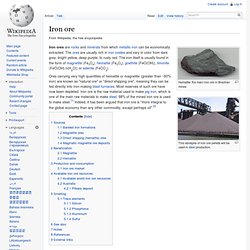
Ores carrying very high quantities of hematite or magnetite (greater than ~60% iron) are known as "natural ore" or "direct shipping ore", meaning they can be fed directly into iron-making blast furnaces. Most reserves of such ore have now been depleted. International Journal of Speleology. The International Journal of Speleology is since 1978 the official peer-reviewed scientific journal of the Union Internationale de Spéléologie.

Since 1981 it has been published by the Società Speleologica Italiana. The International Journal of Speleology is divided into four sections: Botany-Microbiology, Zoology, Geology-Geomorphology, and Abstract-News. The first issue was edited by G. Claus (USA), subsequently two other editors were added: R. Husson (France) and G Nicholas (USA). In 1972 R. Cave painting. Cave paintings are paintings found on cave walls and ceilings, and especially refer to those of prehistoric origin.

The earliest such art in Europe dates back to the Aurignacian period, approximately 40,000 years ago, and is found in the El Castillo cave in Cantabria, Spain. The exact purpose of the paleolithic cave paintings is not known. Evidence suggests that they were not merely decorations of living areas since the caves in which they have been found do not have signs of ongoing habitation. They are also often located in areas of caves that are not easily accessible. Some theories hold that cave paintings may have been a way of communicating with others, while other theories ascribe a religious or ceremonial purpose to them.
History of discovery[edit] Age[edit] Cueva de las Monedas Nearly 340 caves have now been discovered in France and Spain that contain art from prehistoric times. Pit cave. A pit cave, or vertical cave—or often simply called a pit (in the US) or pot (in the UK)—is a type of natural cave which contains one or more significant vertical shafts rather than being predominantly a conventional horizontal cave passage.
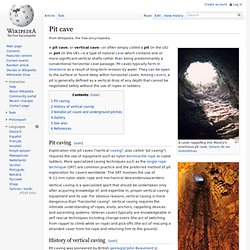
Pit caves typically form in limestone as a result of long-term erosion by water. They can be open to the surface or found deep within horizontal caves. Among cavers, a pit is generally defined as a vertical drop of any depth that cannot be negotiated safely without the use of ropes or ladders. Pit caving[edit] Exploration into pit caves ("vertical caving", also called "pit caving") requires the use of equipment such as nylon kernmantle rope or cable ladders. Vertical caving is a specialized sport that should be undertaken only after acquiring knowledge of, and expertise in, proper vertical caving equipment and its use. Mine rescue. Mine rescue is the specialized job of rescuing miners and others who have become trapped or injured in underground mines because of mining accidents, roof falls or floods and disasters such as explosions caused by firedamp.
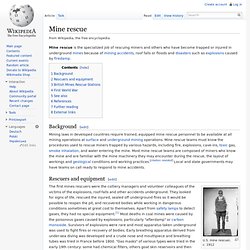
Background[edit] Cave conservancy. A cave conservancy is a specialized land trust that primarily manages caves or karst features in the United States.
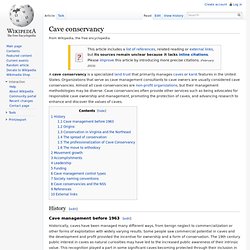
Organizations that serve as cave management consultants to cave owners are usually considered cave conservancies. Almost all cave conservancies are non-profit organizations, but their management methodologies may be diverse. Cave conservancies often provide other services such as being advocates for responsible cave ownership and management, promoting the protection of caves, and advancing research to enhance and discover the values of caves. History[edit] Cave management before 1963[edit] Coal-mining region. World coal producers and consumers. Coal reserves in BTUs as of 2009 Coal mining regions are significant resource extraction industries in many parts of the world.
They provide a large amount of the fossil fuel energy in the world economy. The People's Republic of China is the largest producer of coal in the world, while the United States contains the world's largest 'recoverable' coal reserves (followed by Russia, China, and India).[1] China and the United States are also among the largest coal consumers. Other important coal producing countries include Australia, India, South Africa, and Russia. Crystal Cavern. Mining. Simplified world active mining map Ores recovered by mining include metals, coal, oil shale, gemstones, limestone, dimension stone, rock salt, potash, gravel, and clay.
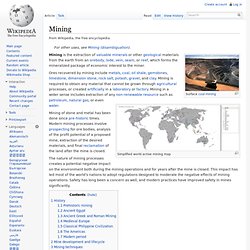
Mining is required to obtain any material that cannot be grown through agricultural processes, or created artificially in a laboratory or factory. Gangue. Cave castle. Predjama grotto castle near Postojna (Adelsberg), Slovenia A cave castle (German: Höhlenburg) or grotto castle (German: Grottenburg) is a residential or refuge castle that has been built into a natural cave.
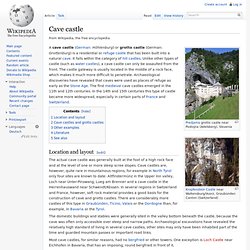
It falls within the category of hill castles. Coal-mining region. Stalagmite. The corresponding formation hanging down from the ceiling of a cave is a stalactite.
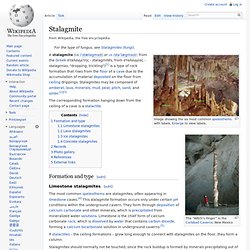
Formation and type[edit] Limestone stalagmites[edit] If stalactites – the ceiling formations – grow long enough to connect with stalagmites on the floor, they form a column. Stalagmites should normally not be touched, since the rock buildup is formed by minerals precipitating out of the water solution onto the existing surface; skin oils can alter the surface tension where the mineral water clings or flows, thus affecting the growth of the formation. Oils and dirt from human contact can also stain the formation and change its color permanently. Lava stalagmites[edit] Another type of stalagmite is formed in lava tubes while lava is still active inside.
The generic term "lavacicle" has been applied to lava stalactites and stalagmites indiscriminately, and evolved from the word "icicle".[2] Mooskappe. The Mooskappe is an old, traditional miners head covering.
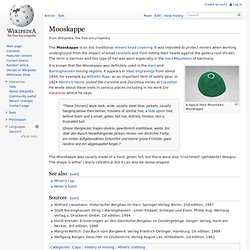
Shovel. A man carrying shovels A shovel is a tool for digging, lifting, and moving bulk materials, such as soil, coal, gravel, snow, sand, or ore. Shovels are common tools that are used extensively in agriculture, construction, and gardening. Most shovels are hand tools consisting of a broad blade fixed to a medium-length handle. Shovel blades are usually made of sheet steel or hard plastics and are very strong. Hard hat. Thermoplastic hard hat A hard hat is a type of helmet predominantly used in workplace environments, such as construction sites, to protect the head from injury by falling objects, impact with other objects, debris, bad weather and electric shock.
Inside the helmet is a suspension that spreads the helmet's weight over the top of the head. It also provides a space of approximately 30 mm (1.2 inch) between the helmet's shell and the wearer's head so that if an object strikes the shell, the impact is less likely to be transmitted directly to the skull. Sometimes the helmet shell has a mid-line reinforcement ridge, which strengthens it against impact. Blue-collar workers, especially union shop construction workers, engaged in occupations that require protective equipment are sometimes metonymically referred to as "hard hats".
Mining accident. Brunner Mine disaster. Mass grave for victims of Brunner Mine disaster. The Brunner Mine disaster happened at 9:30am on Thursday 26 March 1896, when an explosion deep in the Brunner Mine killed all 65 miners below ground. Underground mine ventilation. Drift mining. Mining industry of Egypt. The Turin mining papyrus depicts mines in the Wadi Hammamat and is the oldest known map of its kind. Underground mining (hard rock) Asteroid mining. Outline of mining. The hammer and pick, two basic tools traditionally used in mining for breaking rock, together form a main heraldic symbol of mining and miners.
Undercroft. Modern parking undercroft under a cinema. History[edit] Raise borer. Naples underground geothermal zone. Burial vault (tomb) Underground mining (hard rock) Penn's Cave and Hotel. Ogof Ffynnon Ddu.